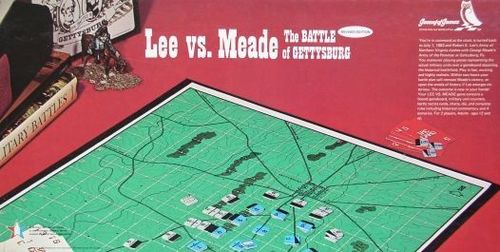|
Advertisement
|
Lee vs. Meade: The Battle of Gettysburg

DescriptionThe Battle of Gettysburg was fought in July 1, 1863 until July 3rd of the same year. It took place in and around the town of Gettysburg, Pennsylvania. Lee vs Meade is a game that covers the Battle of Gettysburg. It was the first game in a series of games put out by Rand known as the 'Command Series Volume I'. The later version put out by Gamut of Games featured a mounted map-board while the original Rand Games version had a map on heavy paper. The map of the Gettysburg area is broken up into a 12x12 square grid. This grid system was used in several of the games developed by Rand Game Associates and was called the Time/Space Grid. Movement costs necessary to go from one square to the next are visible on the grid at the edges and corners between the squares making it easier to move without the use of a movement chart. Unlike some games that use a square grid, diagonal movement is permitted. Another feature common to most of the games offered by Rand Games was fairly elaborate combat sub-routine in which the attacker and defender would each pick a combat method from a 6x6 matrix called the Tactical Analysis Chart and draw the appropriate "Tac Card." These "Tac Cards" are numbered from 1 to 6. The cell on the Tactical Analysis Chart that corresponds to the intersection of the two players' combat methods determines which combat results table is used. There are 6 different types of CRT used in this game. The turn sequence is easy. Firstly the Confederate army moves.Any combat resulting is resolved and then the Union army moves and any combat is resolved. Game DiscussionsAdd CommentYou need to be logged in to comment. Insert Bullet List Please enter at least one item. Item: Item: Item: Item: Item: Insert Numeric List Please enter at least one item. Item: Item: Item: Item: Item: Insert Link Please enter the link of the website Optionally you can add display text Insert Email Please enter the email address Optionally add any display text Insert Image Please enter the link of the image Insert YouTube Video Please enter the link of the video Marketplace | ||||

Comments (0)